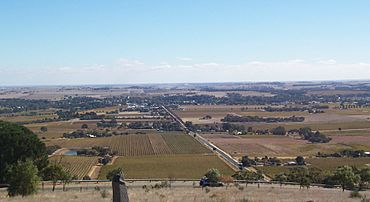Tanunda, South Australia facts for kids
Quick facts for kids TanundaSouth Australia |
|||||||||||||||
|---|---|---|---|---|---|---|---|---|---|---|---|---|---|---|---|

Looking across the vineyards towards Tanunda from Mengler Hill Lookout
|
|||||||||||||||
| Population | 4,710 (2021 census) | ||||||||||||||
| Established | 1848 | ||||||||||||||
| Postcode(s) | 5352 | ||||||||||||||
| Location | 69 km (43 mi) North East of Adelaide via |
||||||||||||||
| LGA(s) | Barossa Council | ||||||||||||||
| State electorate(s) | Schubert | ||||||||||||||
| Federal Division(s) | Barker | ||||||||||||||
|
|||||||||||||||
Tanunda is a lovely town found in the Barossa Valley area of South Australia. In 2021, about 4,710 people lived there, according to the latest count.
Contents
Where is Tanunda?
Tanunda is located about 66 kilometers (41 miles) north-east of Adelaide, the capital city of South Australia.
Tanunda's History
The name Tanunda comes from an Aboriginal word. It means "water hole" or "wild fowl on creek."
Charles Flaxman started Tanunda as a village around 1848. Gold was even found at Tanunda Creek in 1856.
Early Settlers and Villages
In 1842, some Prussian immigrants arrived with Pastor Gotthard Fritzsche. They founded a village called Bethanien. This was the first settlement near where Tanunda is today.
A year later, more Prussians moved from Klemzig to the Barossa Valley. They had first settled in Klemzig in 1838 with Pastor August Kavel. These new settlers started a village called Langmeil. It was named after a Prussian town, now called Okunin in Poland.
Later, another village was founded and named Tanunda. Over time, the villages of Langmeil and Tanunda grew together. Today, the whole area is simply called Tanunda.
Name Changes During Wartime
During World War I, there were strong feelings against Germany. Because of this, Langmeil and Bethanien had their names changed. Langmeil became Bilyara, and Bethanien became Bethany.
However, in 1975, Bilyara went back to being called Langmeil.
Who Lives in Tanunda?
Let's look at how many people have lived in Tanunda over the years.
- In 1986, 2,856 people lived in Tanunda.
- By 2016, the population grew to 4,588 people.
- In 2021, the population was 4,710 people.
A Look at the Community
In 2021, about 51.4% of the people in Tanunda were female, and 48.6% were male. The average age was 48 years old. This is a bit older than the national average age of 38.
Most people (85.0%) living in Tanunda were born in Australia. Other countries of birth included England (4.4%), New Zealand (1.0%), and Germany (0.9%).
English is the main language spoken at home by 93.2% of people. Other languages spoken include German (0.7%) and Mandarin (0.4%).
What Tanunda is Known For
Tanunda and the Barossa Valley are famous for growing grapes and making wine. The town is surrounded by many vineyards.
One special vineyard is called Turkey Flat. It has Shiraz grapevines that were planted way back in 1847. These are thought to be the oldest grapevines in the world that have been making wine continuously.
Tanunda's Railway History
A railway line reached Tanunda and Nuriootpa from Gawler in 1911. Passenger trains used to run regularly until 1968.
Later, special passenger services like the Barossa Wine Train ran from Adelaide to Tanunda. This service stopped in 2003. A local radio station, 5BBB, has been using the old station building since the mid-1990s.
Culture and Traditions
Tanunda still celebrates its German heritage today. The town has a male choir called the Tanunda Liedertafel, which might have started as early as 1850. There is also a Kegel (bowling) club, which is a type of German bowling.
The Tanunda Town Band is very old. It celebrated 150 years as a band in 2007. It is the oldest brass band in the Southern Hemisphere.
Media and Newspapers
In the past, Tanunda was home to some of the first newspapers in South Australia that were printed mainly in German. Many of these newspapers had to close or join together because of a shortage of workers. This happened during the gold rush in the 1850s and 1860s.
Some of these historical German newspapers included:
- Deutsche Zeitung für Süd-Australien (1851)
- Süd Australische Zeitung (1860–1874)
- Australisches Unterhaltungsblatt (1862-1916)
- Tanunda Deutsche Zeitung (1863-1869)
Today, two weekly English-language newspapers serve the area:
- The Leader, which has been around since 1918.
- The Barossa and Light Herald, which started in 1951.


